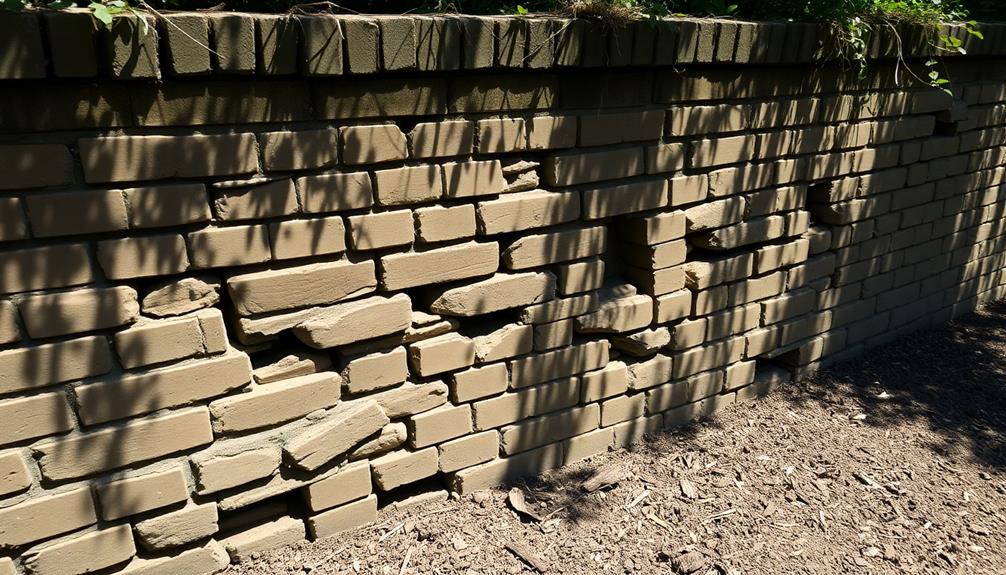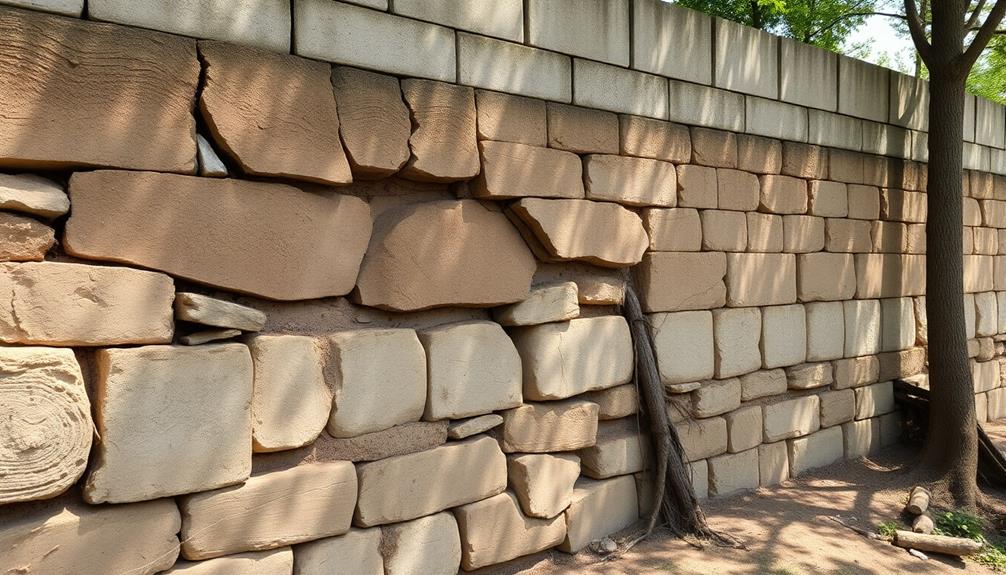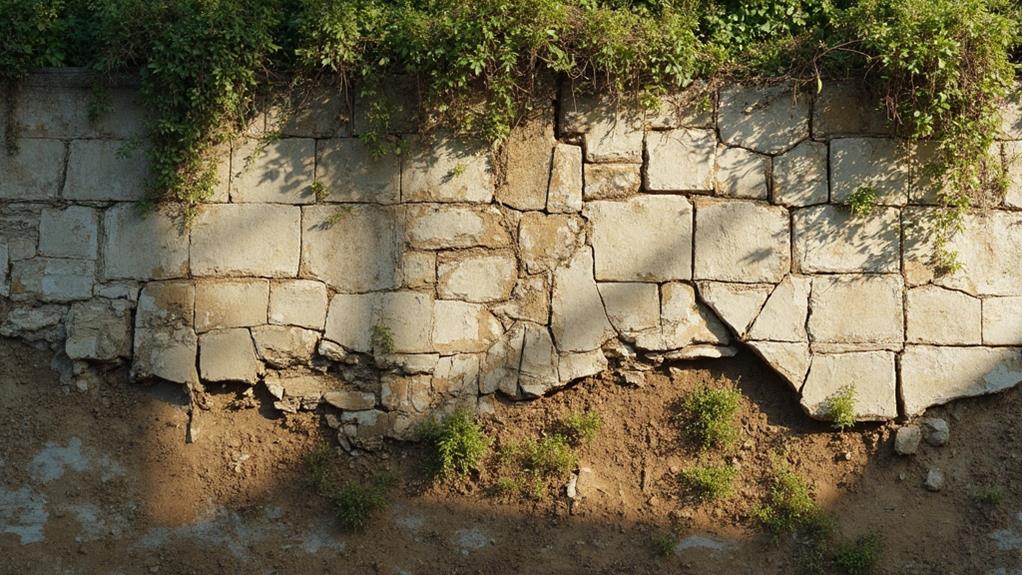When your retaining wall exhibits cracks, bulges, or signs of water drainage issues, it is vital to take prompt action to prevent further degradation or potential collapse. Begin with a professional evaluation to ascertain the root causes, which can range from excessive hydrostatic pressure to soil erosion or poor drainage management. Employ remedial actions such as reinforcing the structure with underpinning or helical piers, enhancing drainage systems with materials like gravel or crushed stone, and stabilizing soil through strategic landscaping. Regular maintenance guarantees the longevity and safety of your retaining wall, and exploring these solutions will provide further insights into effective preservation practices.
Table of Contents
ToggleWalls Contractor Highlights
- Conduct a professional assessment to identify root causes and recommend corrective measures.
- Implement effective drainage solutions to manage water flow and prevent hydrostatic pressure buildup.
- Control soil erosion by utilizing landscaping techniques such as adding vegetation with stabilizing root systems.
- Reinforce or rebuild the retaining wall to restore structural stability and integrity.
- Regularly inspect and maintain the wall to address minor issues before they escalate into major problems.
Signs of Wall Damage

The presence of cracks and bulges in a retaining wall, alongside water drainage issues and uneven wall settlement, serves as critical indicators of structural compromise that necessitates immediate attention. These manifestations often indicate underlying problems related to soil pressure, water accumulation, or foundational instability, each potentially exacerbating the wear and tear on the wall.
Additionally, landscaping retaining walls may show damage if they are beyond their height capacity, further stressing the importance of appropriate material selection. Identifying and addressing these signs early can help in implementing corrective measures that prevent further deterioration and guarantee the wall's functionality and safety.
Cracks and Bulges Formation
Cracks and bulges on a retaining wall often signal underlying structural issues that, if left unaddressed, could lead to serious failures. Such defects can arise from various factors, including soil movement, inadequate design, poor construction practices, or the natural degradation of materials over time. Observing these signs early allows homeowners or property managers to take preventative actions aimed at restoring both the functionality and aesthetic integrity of their walls.
Cracks can manifest in several forms: vertical, horizontal, or diagonal. Vertical cracks generally point towards settlement issues, whereas horizontal or diagonal ones may indicate excessive lateral pressure from the retained soil. Bulging, on the other hand, typically suggests that the wall is yielding under stress, likely from pressure imbalances. It is crucial to recognize that each type of crack or bulge carries implications about the wall's structural health and its future capacity to bear loads.
Seeking professional assessment from qualified structural engineers or experienced contractors can help elucidate the root causes and recommend appropriate measures. By addressing these concerns promptly, individuals strengthen their sense of security and belonging within their communities, ensuring their environments remain safe and reliable for everyone involved.
Water Drainage Issues
Addressing cracks and bulges is only part of the equation when evaluating retaining wall health, as water drainage issues often present equally significant signs of damage. Proper drainage is pivotal to a retaining wall's structural integrity. Water accumulation behind the wall can increase hydrostatic pressure, potentially leading to severe deterioration or failure. Signs that drainage problems may be compromising your wall include persistent wet spots or pooling water at the base. Additionally, efflorescence—a white, powdery deposit on the wall surface—can indicate that water is penetrating and leaching salts from the materials, ultimately weakening the structure.
Ensuring efficient drainage begins with inspecting the wall for clogged or absent drainage systems, such as weep holes or drainpipes. These components must be clear to facilitate proper water flow away from the wall. Overgrown vegetation or accumulated debris can impede this key function. More proactively, integrating a gravel or crushed stone layer behind the wall, along with appropriate filter fabrics, can enhance drainage. Such additions aid in directing water flow, reducing the risk of structural strain. Addressing these issues not only preserves your wall's functionality but also fosters a sense of community pride and safety, enhancing shared spaces.
Uneven Wall Settlement
Signs of uneven wall settlement often become evident through various distinct indicators of structural compromise. These indicators manifest as tilting or bowing, which signifies an imbalance in the wall's foundational support, posing potential risks to its integrity.
Cracks and fissures within the wall's surface are common symptoms, with their presence suggesting that the wall's ability to bear weight is being compromised. As these cracks often widen over time, they necessitate immediate attention to prevent further deterioration.
In addition to visible distortion and cracks, uneven wall settlement can destabilize adjacent landscaping. Soil erosion around the base, for example, not only impacts the wall but also disrupts the surrounding environment, altering drainage patterns and potentially leading to further damage.
Additionally, if your wall supports any structures or paths, their misalignment might become apparent, affecting the overall aesthetics and functionality of your property.
To address uneven wall settlement, a thorough evaluation by a structural engineer is imperative to determine the underlying causes and recommend corrective actions. In many cases, strategic reinforcement, such as underpinning or installation of helical piers, can be employed to restore stability and guarantee the long-term durability of your retaining wall.
Benefits

Addressing retaining wall damage promptly not only safeguards structural stability but also enhances the aesthetic appeal of a property, which can lead to increased property value. Retaining walls can also be a decorative extension of a home, adding to its visual charm.
Proper maintenance and timely repairs contribute to a prolonged lifespan of the wall, ensuring it continues to function effectively while maintaining its visual allure. These benefits underscore the importance of regular evaluations and maintenance to protect one's investment and enjoy the long-term advantages offered by a well-preserved retaining wall.
Increased Property Value
Investing in a well-constructed retaining wall can substantially enhance a property's value, offering significant financial benefits to homeowners. Beyond their aesthetic appeal, retaining walls contribute to improved land usability, which can translate into increased market value. These structural enhancements not only offer a visually pleasing landscape but also maximize functional space, making properties more attractive to potential buyers or renters.
By effectively managing soil instability and preventing erosion, retaining walls preserve the integrity of surrounding land, safeguarding the investment by reducing the risk of damage to other property structures.
Retaining walls personalize the landscape, providing an unparalleled sense of connection for homeowners with their environment. Thoughtfully designed, they can create distinct outdoor spaces such as terraces, gardens, and patios, promoting a sense of exclusivity and belonging within the community. Potential buyers are often drawn to these enhancements, recognizing them as valuable additions that contribute to a heightened living experience.
Moreover, the presence of a durable retaining wall is an assurance of reduced maintenance costs in the long term, a factor which often appeals to budget-conscious buyers. This assurance, coupled with the immediate aesthetic and functional benefits, underscores why a retaining wall can be a worthy investment for property enhancement.
Structural Stability Assurance
Ensuring structural stability is a pivotal benefit offered by retaining walls, as they provide robust support to sloped landscapes. Retaining walls are engineered to withstand lateral pressure from the earth they hold back, which safeguards your property against the hazards of erosion and landslide. This reinforces the integrity of your outdoor environment and encourages a sense of security within your community.
By effectively redirecting water flow and preventing soil erosion, well-constructed retaining walls act as guardians of your property's foundation, promoting long-term sustainability.
Moreover, retaining walls are designed with a focus on ensuring they complement the natural topography, integrating themselves seamlessly into existing landscapes. The technical expertise required in their construction involves careful consideration of materials and design, tailored to suit specific site conditions, effectively mitigating risks of structural failure.
They are often essential in managing stress distribution across uneven terrain, thereby enhancing the functional utility and safety of the area they support.
In sustaining structural soundness, retaining walls further foster a harmonious connection between the built environment and the natural world, aligning with community values that prioritize resilience and environmental stewardship. Their presence demonstrates a proactive commitment to maintaining safe and stable living spaces.
Enhanced Aesthetic Appeal
While retaining walls are fundamentally known for their structural benefits, they also contribute significantly to the aesthetic enhancement of a landscape. These structures, when appropriately maintained and designed, can transform otherwise mundane outdoor areas into cohesive and inviting environments. A well-maintained retaining wall not only reinforces soil and prevents erosion but becomes an integral part of the visual harmony within your property's landscape.
Diverse Materials: A range of materials such as natural stone, brick, or precast concrete blocks provide myriad options for complementing existing architecture and landscaping features. Each material offers distinct textures and colors that can be tailored to meet specific aesthetic preferences.
Design Versatility: The endless design possibilities with retaining walls allow homeowners and landscape architects to employ various shapes and heights, creating terraced gardens or curving contours that add dimension and visual interest.
Complementary Vegetation: Incorporating plants and flowers into or around the retaining wall can further enhance the landscape's aesthetic appeal, providing color and vibrancy while seamlessly blending the structure with the surrounding environment.
For a community that values the integration of beauty and functionality, a damaged retaining wall presents an opportunity not just for repair, but for enhancement and transformation, ensuring that it remains a source of pride and enjoyment.
Prolonged Wall Lifespan
A key advantage of maintaining a retaining wall is the prolongation of its lifespan, which directly translates into long-term cost savings and increased reliability. Well-maintained walls require less frequent repairs, minimizing disruptions and reinforcing their structural integrity over time. This safeguarding of investment fosters financial prudence by curtailing potential costs that arise from neglect or delayed maintenance.
An extended lifespan not only protects against unforeseen expenses but also guarantees sustained functionality, ensuring the wall fulfills its essential roles, such as soil retention and property aesthetic enhancement. By adhering to regular inspections and addressing minor issues promptly, property owners foster a sense of resilience in their infrastructure, which resonates with a community that values stability and security.
Implementing preventative measures, such as waterproofing, proper drainage installation, and periodic cleaning, empowers owners with confidence that their retaining structures will withstand environmental adversities. Additionally, this commitment to longevity enhances the collective appearance and harmony of shared environments, promoting a communal sense of pride.
Ultimately, prioritizing a long-term perspective on retaining wall upkeep strengthens the foundation of any shared space, nurturing an enduring environment marked by both functional and aesthetic harmony. Through these diligence practices, an inclusive commitment to well-maintained public and private areas is celebrated.
Causes of Retaining Wall Failure

Understanding the underlying causes of retaining wall failure is pivotal for effective remediation and prevention, with poor drainage management leading to hydrostatic pressure that compromises the wall's structural integrity, while soil erosion issues can undermine the wall's foundation, causing settling or tipping. In addition, structural design flaws often stem from inadequate consideration of soil characteristics and load-bearing capacities, resulting in insufficient support. The following table highlights the primary factors leading to retaining wall failure:
| Factor | Description |
|---|---|
| Poor Drainage Management | Causes water buildup, increasing pressure on the wall |
| Soil Erosion Issues | Leads to foundation instability and potential wall collapse |
| Structural Design Flaws | Results from improper load calculations and material selection |
| Importance of Soil Analysis | Critical for ensuring adequate support and stability |
| Remedy Actions | Involves drainage solutions, erosion control, and design improvements |
Poor Drainage Management
Neglecting proper drainage management in retaining wall systems can vastly compromise structural integrity, leading to potential failure. Ensuring that water does not accumulate behind a retaining wall is indispensable for its longevity and effectiveness.
Poor drainage management can exert excessive pressure on the wall, potentially causing it to crack, bulge, or eventually collapse. To address these concerns, community members must be aware of the essential components of an effective drainage system:
- Installing Drainage Pipes: Placing perforated pipes at the base of the wall allows water to be directed away from the structure, reducing hydrostatic pressure and preventing water buildup.
- Proper Backfill Material: Utilizing granular backfill material encourages water to flow towards the drainage pipes, facilitating efficient water movement and further minimizing pressure on the wall.
- Regular Maintenance and Inspection: Scheduling regular inspections helps to detect clogs or failures in the drainage system, ensuring timely interventions before major damage develops.
As part of a supportive community, addressing these aspects collectively not only preserves the integrity of retaining walls but also reinforces a sense of responsibility and connection among residents. By prioritizing drainage management, individuals contribute to sustaining their landscape, safeguarding both personal and shared properties.
Soil Erosion Issues
How can soil erosion jeopardize the stability of retaining walls? Soil erosion poses a significant risk to the integrity of retaining walls, undermining their primary function of holding back soil and preventing land displacement. By removing the soil that supports the base of the wall, erosion can lead to destabilization. Over time, as soil is eroded by natural elements such as wind and water, the foundational support of a retaining wall can become compromised. This erosion can occur subtly yet persistently, eventually threatening the structural stability of the wall itself.
Understanding the causes of soil erosion is pivotal for ensuring the longevity and safety of retaining walls. Several factors contribute to soil erosion, including heavy rainfall, inadequate vegetation cover, and improper land grading. Heavy rainfall or water runoff can wash away the soil particles, especially if there is insufficient drainage control in place. Vegetation acts as a natural barrier against erosion by stabilizing the soil with root systems, so when plants are sparse or nonexistent, erosion is more likely to occur. Together, these elements emphasize the need for proper site assessment and maintenance, fostering a sense of stewardship and a sense of belonging in keeping our shared environments safe and secure.
Structural Design Flaws
Structural design flaws substantially contribute to retaining wall failure, posing a threat to both safety and functionality. These deficiencies often originate from inadequate planning and engineering oversight, leading to compromised structural integrity over time. Understanding the implications of design errors is significant for homeowners and property managers aiming to foster a reliable and cohesive community environment.
There are several key factors that frequently result in design-related issues:
- Incorrect Assessment of Load-Bearing Requirements: Properly evaluating the loads a retaining wall must support is essential. Miscalculating soil weight, water pressure, or other environmental factors can lead to premature wall distress or failure.
- Improper Material Selection: Each material possesses distinct characteristics that must align with the wall's intended purpose and environmental conditions. Choosing unsuitable materials can weaken the structure's long-term durability.
- Insufficient Drainage Design: Designing a drainage system that effectively manages water flow is important. Poor drainage results in hydrostatic pressure buildup behind the wall, causing structural instability or collapse.
Walls Contractor FAQ
How Can a Damaged Retaining Wall Affect My Property Value?
A damaged retaining wall can substantially impact property value by signaling potential structural issues, leading to costly repairs and diminished curb appeal. Addressing it promptly helps maintain a safe, attractive property, fostering community desirability and homeowner pride.
What Are the Legal Responsibilities of a Homeowner Regarding a Damaged Retaining Wall?
Homeowners are typically legally obligated to maintain retaining walls in safe, functional condition. This responsibility often includes necessary repairs to prevent property damage or safety hazards, ensuring compliance with local building codes and potentially affecting neighborhood harmony and safety.
Are There Specific Permits Required for Repairing a Retaining Wall?
Obtaining permits for retaining wall repairs often depends on local government regulations and wall specifications. Contacting your local planning or building department guarantees compliance, fostering community trust while avoiding potential liabilities and promoting safety within your neighborhood.
How Do I Choose a Qualified Contractor for Retaining Wall Repairs?
Selecting a qualified contractor involves evaluating credentials, seeking recommendations, and reviewing past projects. Guarantee they hold necessary licenses and insurance. Engage with professionals who share community values, fostering trust and warranting satisfaction in line with collective expectations.
Can Insurance Cover the Costs of Repairing a Damaged Retaining Wall?
Insurance coverage for retaining wall repairs depends on your policy's specifications. Homeowners should consult with their insurance provider to determine if such damages are covered, fostering a sense of assurance and participation in the claims process.







